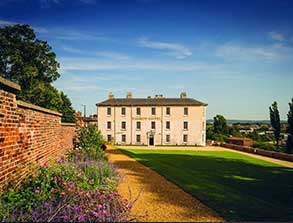One of the nation’s most celebrated coaching inns
The Royal Oak Hotel in Welshpool, Powys, was one of the nation’s most celebrated coaching inns during the early 1800s, being at the meeting point of important roads from Chester, Shrewsbury, Ludlow and Aberystwyth. No-one knows when it was first an inn, but it retains elements of a timber-framed Tudor construction, and must have been an important early building.
It was almost certainly named The Royal Oak Inn sometime after the restoration of Charles II in 1660, which marked the beginning of the popularity of the inn-name. Royal Oak was a metaphor for the strength of the monarchy, and it was Charles II who promoted it most vigorously when he instigated the annual Oak Apple Day, later known as Restoration Day or Royal Oak Day. It seems probable that the owners of Powis Castle at Welshpool, the Herbert family, introduced the name Royal Oak to this important building within their estate as a mark of gratitude for being raised through the ranks of the aristocracy, first by Charles I and later by his two sons, Charles II and James II.
The earliest surviving record of Welshpool’s Royal Oak Inn is a diary entry, dated 1724, by a well-known local Quaker minister, John Kelsall. The inn was completely rebuilt in 1742 to create the building we see today. Despite many alterations since then, the main structure remains intact and retains some important detailed elements of Georgian styling, including a fine central staircase and a superbly crafted wrought-iron inn sign.
Famous visitors to The Royal Oak have included David Lloyd George when he was Prime Minister in 1918 and the Queen and Duke of Edinburgh in 2010. The hotel was acquired in April 2015 by the Coaching Inn Group, which immediately carried out a major refurbishment in order to meet modern customer needs while preserving and keeping faith with the heritage and unique characteristics of the historic building.






































